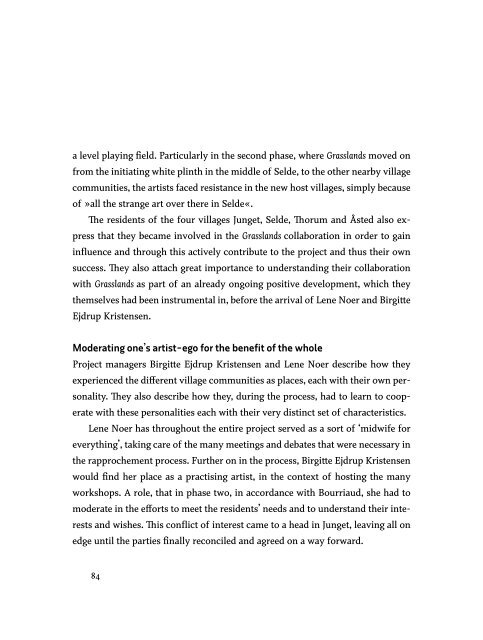Grasslands (eng)
GRASSLANDS has a sharp focus on Danish rural areas, and attempt to contribute to a more nuanced and qualified debate on rural development, through art projects.
GRASSLANDS has a sharp focus on Danish rural areas, and attempt to contribute to a more nuanced and qualified debate on rural development, through art projects.
You also want an ePaper? Increase the reach of your titles
YUMPU automatically turns print PDFs into web optimized ePapers that Google loves.
a level playing field. Particularly in the second phase, where <strong>Grasslands</strong> moved on<br />
from the initiating white plinth in the middle of Selde, to the other nearby village<br />
communities, the artists faced resistance in the new host villages, simply because<br />
of »all the strange art over there in Selde«.<br />
The residents of the four villages Junget, Selde, Thorum and Åsted also express<br />
that they became involved in the <strong>Grasslands</strong> collaboration in order to gain<br />
influence and through this actively contribute to the project and thus their own<br />
success. They also attach great importance to understanding their collaboration<br />
with <strong>Grasslands</strong> as part of an already ongoing positive development, which they<br />
themselves had been instrumental in, before the arrival of Lene Noer and Birgitte<br />
Ejdrup Kristensen.<br />
Moderating one’s artist-ego for the benefit of the whole<br />
Project managers Birgitte Ejdrup Kristensen and Lene Noer describe how they<br />
experienced the different village communities as places, each with their own personality.<br />
They also describe how they, during the process, had to learn to cooperate<br />
with these personalities each with their very distinct set of characteristics.<br />
Lene Noer has throughout the entire project served as a sort of ‘midwife for<br />
everything’, taking care of the many meetings and debates that were necessary in<br />
the rapprochement process. Further on in the process, Birgitte Ejdrup Kristensen<br />
would find her place as a practising artist, in the context of hosting the many<br />
workshops. A role, that in phase two, in accordance with Bourriaud, she had to<br />
moderate in the efforts to meet the residents’ needs and to understand their interests<br />
and wishes. This conflict of interest came to a head in Junget, leaving all on<br />
edge until the parties finally reconciled and agreed on a way forward.<br />
The distinct abilities of the artists are appreciated<br />
What one unequivocally must admire the two project leaders for is their ability<br />
to meet the residents, enter a dialogue with them and to learn from this, along the<br />
way, while maintaining their vision and willingness to see the project through,<br />
despite opposition, misunderstandings and myths, as well as a multitude of practical<br />
and economic chall<strong>eng</strong>es along the way. The residents also specifically commended<br />
this passion and drive, pointing out that they would never have given so<br />
decisive a mandate to one of their own, and therefore would never have been able<br />
to get so far, if Lene Noer and Birgitte Ejdrup Kristensen had not appeared and<br />
taken on the role of midwives.<br />
There is no doubt that after tears come smiles and that all involved have<br />
grown through the collaborative process, and that there still exists a relationship<br />
of trust, as this former proud furniture-producing area of Fursund, has already<br />
established a new ‘chair project’, which at the time of writing is finding its own<br />
four legs to stand on.<br />
There is no singular truth about the results of <strong>Grasslands</strong><br />
I have personally been very absorbed in how the different residents groups have<br />
formulated the stories that have meant most to them. This kind of post-rationalisation<br />
and editing of our narratives is quite common. It is a distinguishing<br />
charac teristic of us as human beings that we create meaning in life by establishing<br />
and editing our narratives about ourselves. The trick is to make room<br />
for these idiosyncrasies, ambivalences and contradictory insights. No one should<br />
have a singular ‘truth’ about the results and successes in such a complex project<br />
as <strong>Grasslands</strong>.<br />
84 85




